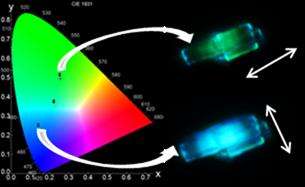Design of a new fluorescent hybrid material that changes colour according to the direction of the light

The UPV/EHUs Molecular Spectroscopy Group, in collaboration with the Institute of Catalysis and Petroleum Chemistry of the CSIC (Spanish National Research Council), has developed a highly fluorescent hybrid material that changes colour depending on the polarisation of the light that it is illuminated by. The research has been published in ACS Photonics, the new journal devoted exclusively to Photonics published by the American Chemical Society.
The aim with respect to hybrid materials with one organic component and another inorganic one is to combine the best attributes of each one into a single system. Labs across the world are working to develop new hybrid materials for technological applications in nanotechnologies, in particular, and these materials are already being used in lightweight materials for cars, sports equipment, in biomimetic materials, like prostheses, etc.
The hybrid material being sought after by the research group in the Department of Physical Chemistry needed to meet a number of very specific requirements. The host inorganic material needed to have a crystalline structure with parallel nanochannels, so that the molecules in the guest organic material, a dye, could be aligned; the size of the pores of the host needed to be less than 1nm (a millionth part of a millimetre) so that the dye would just fit; finally, not just one, but two dyes of similar size and shape were needed, but they had to have complementary optical properties that would respond differently when stimulated by light.
So the main challenge was to achieve that perfect fit between the inorganic nanostructure and the dye molecules. They achieved it by using as the host material an aluminophosphate (AIPO-11) that has a suitable pore size to accommodate dyes with a structure of three fused benzene rings, like the chosen ones: pyronin, with green fluorescence, and acridine, with blue fluorescence. The dyes enter in order, they align themselves along the nanochannels, and their fluorescent properties are improved in them, explained Virginia Martinez, a Ramón y Cajal researcher in the Molecular Spectroscopy group. The improvement is due not only to the fact that the molecular flexibility of the dye is restricted, but also because the latter is included monomerically, in other words, it enters the channel in separate units, and thanks to that they are highly luminescent because the fluorescence is lost when they are added.
To obtain that perfect fit, the synthesis procedure played a fundamental role. Usually, in photoactive hybrid materials the organic part is inserted into the inorganic part from the gas or liquid phase by means of diffusion, but with this method the occlusion level that this research needed was not achieved. So they opted to insert the dye into the gel with which the inorganic material is synthesised, so that as the crystal grew the organic chromophore would be gradually incorporated.
At the beginning, they inserted a single dye, pyronin, and obtained a highly luminescent material. In fact, by using confocal fluorescence microscopy, they recorded an almost total aligning of the dye molecules along the channel (dichroic ratio of 40), an alignment that had not previously been reported.
They then went on to incorporate pyronin and acridine into the synthesis process at the same time and obtained rectangular crystals of 30 x 20 microns that strikingly changed colour depending on the polarisation of the light they were being illuminated by: if the polarisation took place along the channel it was seen as green; if it occurred perpendicularly, it displayed the colour blue. This behaviour indicated that a transfer of energy was taking place between the dyes.
The tuning of colour is also an instantaneous, efficient process that can be fully reversed and reproduced with high resistance to fatigue," pointed out Iñigo López-Arbeloa. So the potential applications of photoactive hybrid materials of this type are numerous: they can be used as antenna in photovoltaic cells, to store information, in photonic cables, in laser systems, etc. In fact, the new hybrid material constitutes an advance in the development of tunable solid-state lasers, of great biomedical interest, since they are easier to use and less polluting that the liquids currently being used.
More information: Virginia Martinez-Martinez, Raquel Garcia, Luis Gomez-Hortiguela, Rebeca Sola-Llano, Joaquin Perez-Pariente and Inigo Lopez-Arbeloa. "Highly Luminescent and Optically Switchable Hybrid Material by One Pot Encapsulation of Dyes into MgAPO-11 Unidirectional Nanopores." ACS Photonics. (2014) 1(3) 205-211.
Provided by University of the Basque Country




















